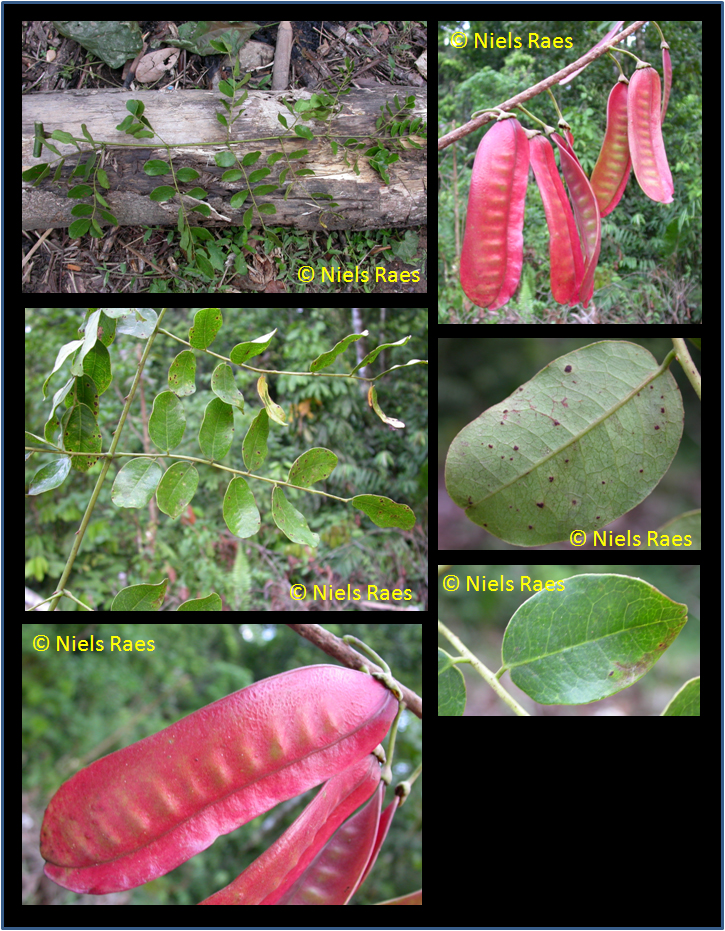Caesalpinia latisiliqua (Cav.) Hattink, Reinwardtia 9(1): 37 (1974)
Name meaning 'wide pods'.Synonyms
Bauhinia latisiliqua Cav.
Caesalpinia torquata Blanco
Mezoneuron balansae Gagnep.
Mezoneuron cabadbarense Elmer
Mezoneuron glabrum "sensu Fern.-Vill., non Desf."
Mezoneuron keo Gagnep.
Mezoneuron latisiliquum (Cav.) Merr.
Mezoneuron oxyphyllum Gagnep.
Mezoneuron platycarpum Merr.
Mezoneuron rubrum Merr.
Mezoneurum balansae Gagnep. [Spelling variant]
Mezoneurum latisiliquum (Cav.) Merr. [Spelling variant]
Mezoneurum oxyphyllum Gagnep. [Spelling variant]
Mezoneurum procumbens Blanco
Description
Liana or small tree, up to 20 m; branchlets unarmed or with a few prickles. Stipules triangular, c. 2 mm long. Leaves: rachis 20-40 cm;
pinnae 4-8 pairs, 7-13 cm. Leaflets alternate to subopposite, sometimes some of them opposite, 6-8 pairs per pinna, petiolulate (1-4 mm),
membranous to coriaceous, oblong or obovate, 1.5-7 by 0.75-5 cm; base unequal to subequal. truncate, obtuse, or cuneate; apex rounded,
truncate, or retuse; glabrous or appressed shortly hairy. Inflorescences axillary and terminal, paniculate, 30-100 cm long, the rachis
unarmed; pedicels 10-20 mm. articulated at the base. Flowers pubescent or glabrous. Hypanthium 3-5 mm deep and 7-12 mm wide. Sepals:
lowest one twice as long as the others. 7-15 by 6-8 mm. Petals: standard arched, bilobed to about half of its length, 8-12 (-19) by
6-l0 (-14) mm, 1-2 mm wide at the base; the other petals 2-6 by 1.5-3 mm, shortly clawed or sessile, often ciliate. Stamens far
exserted; filaments c. 14 (-22) mm; anthers 1-2 mm. Pistil pubescent or glabrous; ovary c. 5 by 1 mm, flat, 6-13-ovulcd; style
c. 8 mm, stigma oblique, hairy along the margin. Pods (pedicels 15-31 mm) 10-16 by 3-5 cm (incl. 10-15 mm wide wing at the upper side),
indehiscent; base cuneate; apex variable, 6-9 (-13)-seeded. Seeds ellipsoid, 9-12 by 6-7 mm, flat, brown, dull" [From Flora Malesiana
I, 12, 2: 547:548).
Ecology
Rocks on sunny hot dry slopes, riverbanks and roadsides, primary forest and forest fringes, from 100 to 1500 m altitude.
Uses
In the Philippines, young shoots eaten as salad. Decoction of leaves given to relieve asthma.
Distribution
From Vietnam and the Philippines to Malaysia, Indonesia and New Guinea.
Local names
Philippines: Sapnit.
